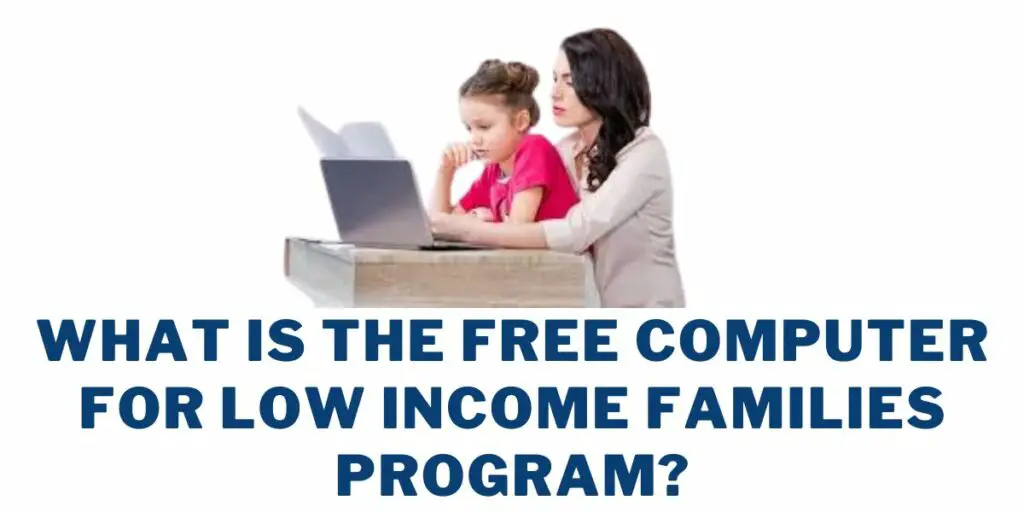Free Computer for Low Income Families: How to Get

We were missing out on many things as a family without access to a computer since we could not afford it.
Luckily, my brother discovered a program offering free computers for eligible families.
We qualified and applied, and now I’m typing on our newly acquired laptop.
In this article, I provide details on how you can also acquire your Free Computer for Low Income Families.
What is the Free Computer for Low Income Families Program?

The Free Computer for low income families Program is an initiative aimed at providing free or low-cost computers to low-income families with a source of income that is low.
And for our esteemed disabled veterans, don’t miss the Free Computers for Disabled Veterans initiative—a seamless offer ensuring no one gets left behind.
Top 5 Ways to Get a Free Computer for Low Income Families
These are the Top 5 Ways to Get a Free Computer for Low Income Families:
1. Federal Lifeline Program
The federal lifeline government program provides discounts on phone and internet services and includes free or discounted computers for low-income families.
2. Nonprofit Organizations
Numerous non-profit Organizations like PCs for People, World Computer Exchange, and Freecycle offer refurbished computers to eligible low-income families.
If you are a Nonprofit organization seeking computer donations, don’t miss my post on Free Computers for Nonprofits.
3. State and Local Initiatives
Many states and cities have programs, like the California laptop loan program, New York City Human Resources Administration, and Texas Digital Divide Initiative, providing free computers to residents meeting specific criteria.
Check out my post on Free Used Computers Near Me to discover to places to get free computers in your area.
4. Schools and Libraries
Some schools and libraries, such as Baltimore City Public Schools, Seattle Public Library, and Miami Dade County Public Library System, offer free or discounted computers to students and community members.
If you’re homeschooling and looking for free computers, follow my guide on how to get Free Computers for Homeschoolers.
5. Technology Recycling Programs
Companies and organizations often recycle old computers, some of which are refurbished and distributed to low income families.
Top 5 Free Computer Providers for Low Income Families

These are the Top 5 Free Computer Providers for Low Income Families:
1. PCs for People
PCs for People is a leading non profit offering affordable and refurbished computers with internet access options. They focus on internet access and provide affordable computers with subsidized internet plans.
2. World Computer Exchange
The World Computer Exchange collects and distributes used computers internationally, prioritizing education and healthcare sectors, thereby focusing on underserved communities.
3. Freecycle
The freecycle is a network of online communities where people give away unwanted items, including computers, for free.
4. National Cristina Foundation
The National Cristina Foundation provides refurbished computers to low income families and individuals with disabilities.
5. Local Technology Access Centers
Many communities have centers that provide free or deeply discounted computers to low income families through partnerships and donation programs. Such centers Include Detroit Community Technology Alliance and Open Technology Initiative Minneapolis.
On It Foundation also offers free laptops for qualified individuals! Check my post on On It Foundation Free iPad for details.
How to Get a Free Computer for Low Income Families
Follow these steps to Get a Free Computer for Low Income Families:
- Check Eligibility: Each program has its criteria, often based on income, participation in government assistance programs, or student status.
- Find a Provider: Research programs and organizations in your area offering free computers.
- Apply Online or In Person: Complete the application process, providing required documents like proof of income and program eligibility.
- Get Approved: You will receive your computer directly or pick it up at a designated location.
- Set Up and Learn: Most programs offer basic setup and training to help you get started with your new computer.
Also, check out my guide on the Free Government Laptops Application Form to learn how to apply and secure your hands on free government laptops.
Eligibility Criteria
These are the Eligibility Criteria to get a Free Computer for Low Income Families:
- The programs require residency in their specific state, city, or region.
- Your income level must be within the thresholds based on the Federal Poverty Guidelines.
- You must participate in government assistance programs like SNAP, Medicaid, or student status.
Required Documents
These are the Required Documents to get a Free Computer for Low Income Families:
- Proof of income (tax returns, pay stubs, etc.)
- Proof of residency (Government issued photo ID, utility bills)
- Proof of government program participation (benefits card, program letter, etc.)
- Household composition documentation (birth certificates, adoption papers)
- Completed application forms for the specific program
You can also get a free computer if you have Medicaid. Check out this post on Free Laptop with Medicaid to learn more.
Top 5 Computers Offered for Free for Low Income Families
These are the Top 5 Computers Offered for Free for Low Income Families:
1. Dell OptiPlex 3020
The Dell OptiPlex 3020 is a reliable workhorse for everyday tasks, offering decent power and storage. It is best suited for browsing, emailing, and word processing.
Specs: Intel Core i3 processor, 4GB RAM, 500GB HDD, Windows 10.
If you love Dell products, check out our guide on How to Get a Free Computer from Dell for detailed steps and information.
2. HP ProDesk 400 G6
HP ProDesk 400 G6 is a newer desktop option than Dell, offering slightly better performance for everyday tasks and basic multimedia. Like the OptiPlex, not suited for demanding workloads.
Specs: Intel Pentium G4560 processor, 4GB RAM, 1TB HDD, Windows 10.
3. Lenovo ThinkPad T440p
This is a rugged business laptop built to last. Its excellent keyboard and durability make it perfect for office work and light multimedia. However, its older models might struggle with modern graphics intensive tasks.
Specs: Intel Core i5 processor, 8GB RAM, 256GB SSD, Windows 10.
Lenovo also offers free tablets to eligible individuals! Check out my post on Free Lenovo Laptop to discover how to get one.
4. Samsung Chromebook 4
The Samsung Chromebook 4 is a web surfing champion, ideal for online learning and basic productivity. Long battery life and lightweight design make it highly portable.
Specs: Celeron N4000 processor, 4GB RAM, 32GB eMMC storage, Chrome OS.
5. Apple MacBook Air (Refurbished)
The powerful and versatile Apple MacBook Air easily tackles browsing, multimedia, and even light professional work. This excellent build quality and user experience come at a price. Though it is the priciest option, even when refurbished,
Check out my guide on Free Laptop from Apple to discover ways to get a Macbook through other programs.
Free Computer for Low Income Families Comparison Table
This table compares the free computer for low income families:
| Feature | Dell OptiPlex 3020 | Lenovo ThinkPad T440p | HP ProDesk 400 G6 | Samsung Chromebook 4 | Apple MacBook Air (Refurbished) |
|---|---|---|---|---|---|
| Type | Limited offline functionality, relies on the internet | Laptop | Desktop | Laptop | Laptop |
| Operating System | Windows 10 | Windows 10 | Windows 10 | Chrome OS | macOS |
| processor | Intel Core i3 processor | Intel Core i5 processor | Intel Pentium G4560 processor | Celeron N4000 processor | Intel Core i5 processor |
| RAM | 4GB | 8GB | 4GB | 4GB | 8GB |
| storage | 500GB HDD | 256GB SSD | 1TB HDD | 32GB eMMC | 128GB SSD |
| Strengths | Reliable, good for basic tasks, decent storage | Rugged, excellent keyboard, handles office tasks | Newer, slightly better performance | long battery life, portable | Powerful, versatile, excellent build quality |
| Weaknesses | Older, not for demanding tasks, less portable | Older, graphics intensive work might struggle | Not suited for demanding workloads, less portable | Limited offline functionality, relies on internet | less upgradeable |
| Typical Use | Browsing, word processing, email | Office tasks, light multimedia | Everyday tasks, basic multimedia | Web browsing, online learning, basic productivity | Browsing, multimedia, light professional work |
| Portability | Low | Medium | Low | High | High |
How to Choose the Best Free Computer for Low Income
Consider these points to Choose the Best Free Computer for Low Income:
- Your needs: basic tasks, online learning, work, or entertainment.
- Check the computer’s specs: processor, RAM, storage, and operating system.
- Think about portability: desktop vs. laptop.
- Choose a model that suits your comfort level with technology.
To get a free laptop from the government, check out my post on ACP Free Laptop.
Benefits of Getting a Free Computer for Low Income
These are the Benefits of Getting a Free Computer for Low Income:
- Access to education and online resources.
- Improved communication and job opportunities.
- Digital literacy and skill development.
- Increased family connectivity and entertainment.
How Can I Get a New Computer for Free?
Follow these steps to Get a New Computer for Free:
- Check for Government and Non-Profit Programs: Some government and non-profit organizations offer free computers to low-income families and students.
- Explore Scholarships and College Programs: Certain scholarships and colleges provide free laptops to students.
- Research Online Opportunities: Websites like Craigslist, eBay, and Amazon Prime Student offer potential avenues to obtain free or discounted computers.
- Complete Application Processes: Follow their specific application procedures once you identify a relevant program or opportunity.
Who Has Free Computers to Use?
Many libraries and community centers offer public computers for free use, although internet access and usage times may be limited.
FAQs on Free Computer for Low Income Families
These are the frequently asked questions on Free Computer for Low Income Families:
Is the Free Computer for Low Income Families limited to certain regions or states?
Numerous independent initiatives and partnerships exist across the US, each with its geographical coverage. However, many states and cities offer such programs, so finding options near you is likely.
Are there any additional costs associated with receiving a free Computer?
While the computers themselves are typically free, some programs might have minimal associated costs, such as application fees, software licenses, and security deposits.
Can families choose the Computer model they receive?
Families cannot choose a specific model. Programs often distribute computers based on available inventory and the recipient’s needs. They prioritize functionality and suitability for intended use over specific models.
What happens if the provided Computer is damaged or lost?
Specific damage and loss policies vary across programs. Most require recipients to take reasonable care of the equipment and might hold them responsible for damage through negligence or misuse. Some programs offer warranties or replacement options under certain conditions.
Is internet access included with the provided Computer?
No, programs primarily focus on hardware. However, some might offer information about affordable internet options or connect families with local internet access initiatives.
Conclusion
Free computer programs open doors to a world of possibilities for low income families. Using these resources, you can bridge the digital divide, empower yourself, and unlock a brighter future.

